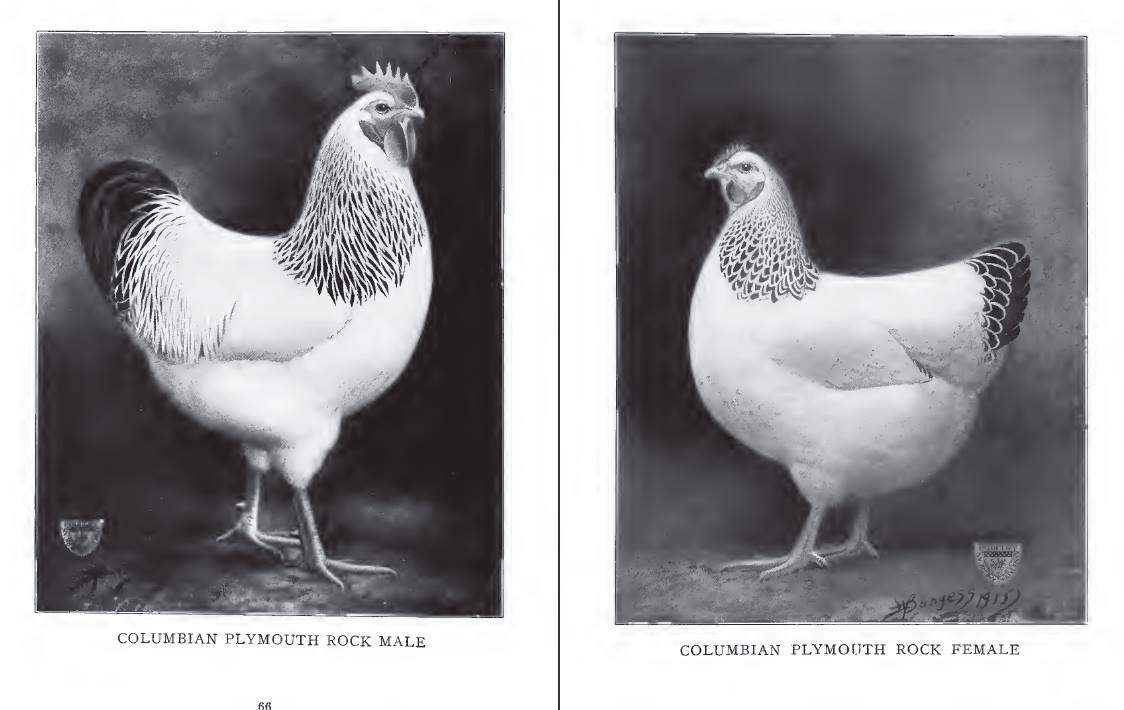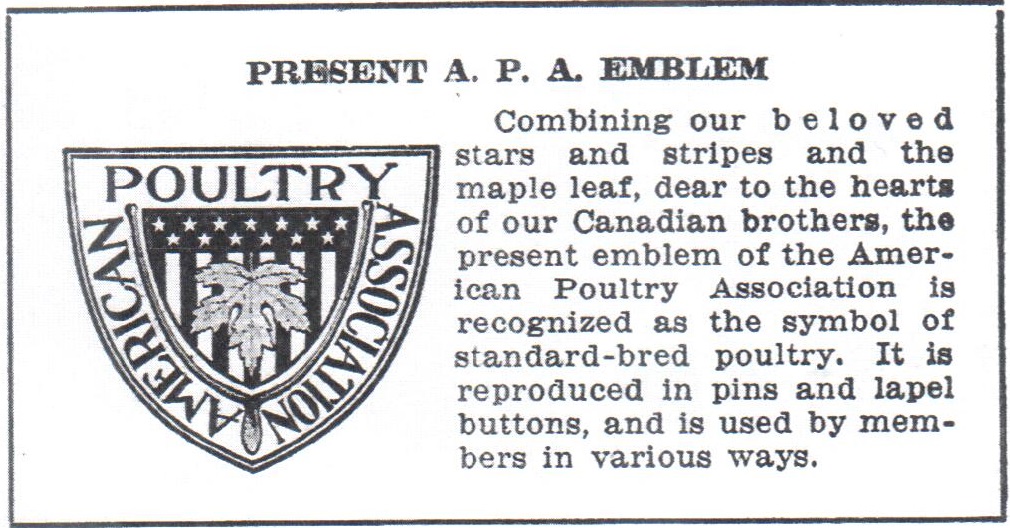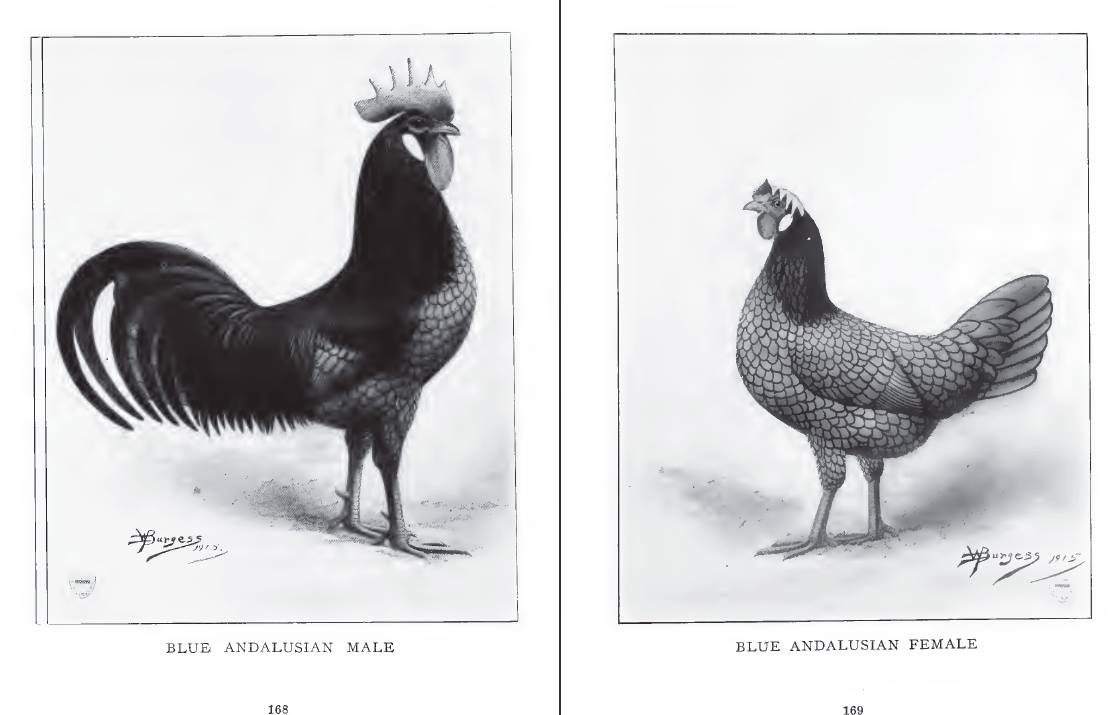This is a reprint of an article by John Robinson from the Reliable Poultry Journal on the Origin of the APA:
The real beginning and origin of the APA antedates by nearly a quarter of a century the events described as official records of organization. The first poultry show in America was held at Boston in 1849. Its primary object was to submit the claims of rival breeders of imported races of poultry to an impartial group of judges, who would decide by inspection and comparison of the varied types shown under similar names, which were typical and pure, and which were not.
When the fowls were brought together it appeared that the confusion of types, breeds and varieties was so great that it was useless to attempt to classify and “judge” the exhibit within the allotted time. So no attempt was made to carry out the original purpose of the exhibition.
A few months after this first show an association was formed to continue the show and to provide ways and means of properly classifying and judging the exhibits. Again the plan failed because the measures devised to apply to such a collection of poultry as had been brought together at the first show were utterly inadequate for the situation confronting the managers when the entries for the second show were in place.
At the 1849 show there had been not quite 1600 birds. At the 1860 exhibition, held in the same tent, in the same place, there were nearly 12,000. The greater part of this was poultry. There were few pigeons, and almost no pet stock. It was, so far as I can learn, by far the largest exhibition of poultry ever brought together. From the brief accounts of it that have come down to us, it was about half “pure bred” races, and the remainder was of crosses and grades, and old “native” local varieties.
The large tent in which this aggregation of poultry was placed covered an area about equal to that of the arena at Madison Square Garden. The coops and boxes of all sorts and sizes, containing the exhibits were piled from the ground up, four or five high. The principal named breeds were shown in classes, but the rest were piled up indiscriminately. The place was so crowded that it was hard to see the birds, and the idea of trying to judge them was abandoned.
 The dismal failure of this huge show reacted very unfavorably upon the interest in poultry. It was apparent that some way of keeping nondescript stock out of exhibitions must be found before it would be possible to judge stock of distinctive character for quality; but no authority for doing anything of the kind existed.
The dismal failure of this huge show reacted very unfavorably upon the interest in poultry. It was apparent that some way of keeping nondescript stock out of exhibitions must be found before it would be possible to judge stock of distinctive character for quality; but no authority for doing anything of the kind existed.
In this situation the movement for special poultry shows declined, and poultry exhibitions were limited generally to agricultural fairs, where exhibitors entered their birds as they pleased, and judges made standards as they pleased–either in accordance with their personal fads, or to give the awards to favored exhibitors.
Where a judge, or the judge who dominated a committee of three judges, had a good perception of the underlying principles of standard-making and was capable and honest there was steady progress toward better standards and better stock. But much of the judging tended to confusion, and even between the most capable and honest judges there were differences of opinion and practice that in their final effect were as troublesome as the errors of the incompetent, or the misdoings of the crooked. There were no written or printed standards, and but one or two breed standards, printed as models by some early poultry writers. Every judge was a law unto himself, and no exhibitor had anything definite to guide him in breeding and selecting birds for exhibition. .
Accept Modified English Standard in 1867
This was the situation until 1867. Then the recently made English Poultry Club Standards were reprinted in America with some alterations and modifications. With these in the hands of exhibitors and judges, competition in exhibition poultry was soon put on a more satisfactory basis. Shows became more numerous, breeders multiplied and the number of good judges increased.
A few years experience with the Americanized-English Standard of Excellence showed that under it there could not be free and harmonious development of poultry culture in America. In the first place the distribution of English Standards here had been an individual undertaking, and two different publishers had each given us his own version. Neither of these publishers, nor the English poultry Club, had any authority here.
Further, with the growth of “the poultry fancy” in America it became more and more apparent that there was a wide gulf between English and American ideas of the principles which should govern in the making and applying of standards: the English fancier being prone to carry conspicuous features to extreme developments, while the American ideal was to secure the perfect combination of characteristics, and the finest development of each character, never sacrificing quality at one point to excessive development of another more favored feature.

The Origin of the APA Organized
The preliminary steps in the origin of the APA were made at Boston in January, 1873. The rather informal conference there relating to the matter adjourned to meet at Buffalo in the following month. The permanent organization was thus effected at Buffalo, February, 1873.
The announcement of the new organization met with a storm of protest from breeders who had not been advised of the proceedings, and who thought that they should have been consulted. It was freely charged that the organizers had kept the movement as quiet as possible until the permanent organization was effected, that they might assure themselves of control. This was vigorously denied, but the dissension aroused was so great that the organizers thought it advisable to reorganize at the annual meeting, thus letting the objectors in as charter members, and giving the opportunity for those not present at the original organization to put in a different set of officers, if they had the votes and so desired.
This ended active controversy over the matter but did not otherwise help the situation. Rightly or wrongly, those who had been left out in the first organization believed that it had been done by design. Few of them were persuaded to take part in the reorganization, and the feeling that had been aroused remained in the East, and especially in New England, until most of the parties to the dispute had passed away.
It was the existence of this strong hostile element when the interest in improvement of poultry was most intense that restricted the growth and the usefulness of the American Poultry Association so seriously during the first three decades of its history. Notwithstanding this opposition, the prestige of the men who organized the association was sufficient to secure recognition for it as the supreme authority in making Standards, deciding what breeds and varieties were worthy of a place in a general Standard of Excellence (as the Standard of Perfection was first called) and making rules for the application of the Standard.
This much authority, even those most hostile to the organization were obliged to concede it, because it was plain that some such organization had to be recognized, and equally plain that no rival organization would be recognized by the rank and file of poultry keepers who were not at all interested in the “politics” of the situation. But this was as far as the malcontents would go, and it was because of their attitude that the association was not able at the beginning to establish that control over the judges and the shows which logically ought to have gone into effect with the Standard.
From the time of its organization until 1902 the Association after the failure of its first attempt to license judges, gave no attention to anything but the making and revising of the Standard of Perfection and the admission of new breeds and varieties to the Standard. During much of that period, and often within the past twenty years, the devotion of the American Poultry Association to the Standard was mentioned as a reproach. It was said to be concerned only with the appearance of poultry and to be utterly indifferent to other possibilities of service to poultry interests.
Of the important result of this concentration on Standards, I will write more particularly a little farther on. It may be said here that devotion to the Standard at least had the advantage of keeping the association out of efforts to frame a constitution suited to the complex functions of an organization trying to adapt itself to the regulation of all things in the poultry world in need of regulation.
About 1902 the Association entered the still uncompleted period of effort to establish a national organization working for the advancement of every form of poultry interest. The constitution adopted at this time for this purpose was a hastily made personal plan of the secretary, put through almost without discussion at a meeting attended by only a handful of members. It brought no actual practical results. Other than that by providing a salary for the secretary a little more substantial than the former honorarium of one hundred dollars, it obtained more service, which service was directed principally to increasing the membership.

Building a Constitution for the Origin of the APA
More members were added then within a few years than in all the previous history of the origin of the APA. At the same time through increased sales of an improved and illustrated edition of the Standard of Perfection the finances of the organization were put on a basis which made it possible to undertake the expense of bringing together a large and representative committee to make a constitution suitable for a national organization performing all the appropriate functions of such an organization.
Out of the deliberations of this committee came the constitution adopted at Auburn, N. Y., in 1907. Without attempting a full analysis of this constitution, it may be said that its principal provisions were the organization of “branches” on a basis which would eventually result in an international organization composed of state and provincial associations; the establishment of an executive board composed of the presidents of these branches and the general officers of the Association; the employment of a full-time secretary, and the appointment of standing committees to deal particularly with certain phases of the work of the Association.
Under this constitution a very large increase in membership was made; yet it had defects plainly evident, and in 1913 a committee was appointed to recommend a plan, incorporating it in a revision of the Constitution and By-Laws, which would overcome the faults discovered in the working of the Constitution and develop a more efficient organization.
The Constitution recommended by this committee was adopted in 1914, but was never fully put into effect. Its operation called for some changes that perhaps most of those who approved it had not foreseen, and in so far as such provisions were concerned it was a dead letter. Another revision of the Constitution in 1919 made other provisions which have never been operative, and at the last annual meeting provision was again made for a committee to revise the Constitution.
To many people not familiar with the origin of the APA, and having little appreciation of the difficulties of devising a form of organization which will unite the diversified poultry interests of a continent for harmonious progress, it seems both strange and discreditable that an association celebrating its Semi-Centennial should still be in the rudimentary stages of progress in all that relates to the ordinary routine functions of an organization of its kind, and those who take this view generally are very prone to speak disparagingly of what the Association has accomplished in standardizing poultry.
Yet the truth is that what has been accomplished by the origin of the APA through the making and revision of the Standard of Perfection is the greatest work in all the history of the improvement of domesticated live stock. In making this statement I am fully aware that people who do not realize and appreciate the results will consider it utterly preposterous. Their views do not concern me. I know whereof I write.
 In the first American Standard of Excellence, the fathers of the Standardbred poultry industry of America and origin of the APA expressed certain principles, not before adequately or formally recognized in live stock standards. They set “a harmonious perfection of all the parts” as the ideal to be sought in breeding and applied in judging. They introduced into standard-making and breeding the idea of what may be termed “equality of excellence” in every character and at every point.
In the first American Standard of Excellence, the fathers of the Standardbred poultry industry of America and origin of the APA expressed certain principles, not before adequately or formally recognized in live stock standards. They set “a harmonious perfection of all the parts” as the ideal to be sought in breeding and applied in judging. They introduced into standard-making and breeding the idea of what may be termed “equality of excellence” in every character and at every point.
They did not at the same time adopt and adjust all parts of the Standard to this idea, and the application of the Standard exclusively to promoting this idea or principle, but they did make the idea so emphatic that it has been the governing factor in the development of improved races of poultry in America. No one can come much in contact with Standard poultry and the people interested in it, without being influenced by this idea. For nearly a score of years past it has been so ingrained in the minds of progressive poultry keepers all over this continent that it may be truthfully said that the philosophy of the Standard has become the common philosophy of poultry folks.
American Standard poultry today, when bred to the requirements of the American Standard of Perfection, has uniformly a finish and quality which elsewhere are obtained in only a few breeds and varieties; and it has this peculiar excellence because the American Poultry Association has persistently worked “for the perfection of the Standard of Perfection,” and every breeder and judge of Standard poultry in his sphere and according to his opportunity and ability has been “doing his bit” to teach the masses of poultry keepers to follow the Standard.
We can find from time to time here and there, poultry keepers in America, professing high interest in poultry and at the same time declaring against the influence of the Standard. They never stay in that position. They either grow into a reasonable conformity to Standard ideas, or they lose interest in poultry. They may deny the authority of the Standard makers but they must accept its results. The whole tendency of progressive improvement of breeds and varieties of domestic poultry in America is toward the more extensive application of the philosophy of Standard-making embodied in the Standard of Perfection, and this is not a small or mean accomplishment for an organization fifty years old.
If the Association had done nothing else, this would give it a claim to high honor. But, though it has done nothing else comparable with this in results we must remember that this is the one and only work upon which it has been engaged its full half century, and that its serious efforts to organize for general service cover barely a score of years. In the matter of organization, it is today where it was in the matter of Standardization of improved breeds thirty years ago. If it were indifferent to its general responsibilities there might be grounds for fear that it would fall to measure up to the demands upon it. As long as each failure to make the constitution efficient is followed by renewed effort to correct its faults, we are warranted in believing that eventually a form of government will be devised that will accomplish all that can be demanded of a general organization.
Origin of the APA By John Robinson
